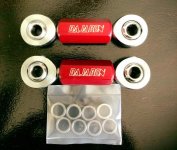Snoking1127
Well-known member
Hopefully, I can clear things up a bit. Probably more information than you're looking for. But I want to cover all the bases because these are good and important questions being asked.
Our long past, aluminum dog bone links had trunnion bearings. These are basically spherical ball bearings with the spacers machined in giving you a 1 piece assembly. This makes installation of a bar kit easier. But trunnion bearings are a rare bird and have to be custom made. This raises the price a bit. But it is the production and assembly process to incorporate the race that really increases the price of a trunnion bearing. A trunnion bearing cannot be quickly, easily, or cheaply pressed into a race like a spherical bearing. For a trunnion, the race must be built around the bearing. A much slower and costlier procedure. In addition to this, it is more difficult to get the needed, close tolerance between the bearing and the race. Bottom line. If you don't REALLY need a trunnion bearing, it can be an expensive headache for all but the bar install for the end user. (Which is not an unimportant consideration, by any means)
OEM, BRP plastic links use a Trunnion bearing. But to avoid the added expense, BRP uses no race at all. The bearing simply presses into the compliant plastic. This is why their links have an extremely tight fit to the bearing. If they were not tight, the bearings would fall out as the plastic gives under stress. Some are simply too tight and will not move. In these cases, the plastic link itself will bend and twist.
Our earlier dog bone links with trunnion bearings work extremely well for most customers. But for those who ride in salt environments, they may rust. Not good. I tried many different angles to get a better quality trunnion bearing. To get what I wanted, it was just way too much money. So, we decided to look into other ways of achieving a higher quality bearing that would be impervious to the elements.
We ended up going with spherical bearing rod ends. This, of course, meant spacers, which I was trying to avoid. But it also meant a good deal of cost savings which we could put towards a much better end product. Namely, a hardened, heat treated, chromoly steel rod end with a hard chromed spherical ball bearing in a self lubricating nylon race. The end cost was a little more than the previous trunnion product. But the tolerances and quality were much improved. Pictured below is our current link set for the Ryker. The Spyder links are the same, just in a larger size.
Now to the Spacers.
Spacers for the Spyder link sets are machine tapered stainless steel. Originally, they were aluminum, which worked well enough. But we found that the machine tapered stainless steel were a better fit for the Spyder.
Spacers for the Ryker have always been aluminum. These seem to be working very well for the Ryker.
That is pretty much it. Other than some vendors are still posting outdated instructions. Be assured that all bar kits are being sent out with current instructions. I am not aware of any issues in this regard.
Questions are always welcome. The more you know, the better your odds of getting what you want the 1st time.
When were the Spyder spacers switched to SS? Bolt the sway bars I installed appeared to have the stepped aluminum ones.

